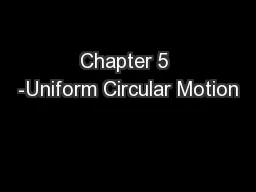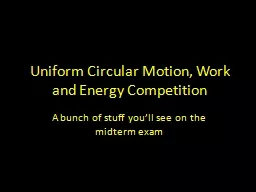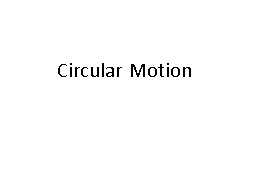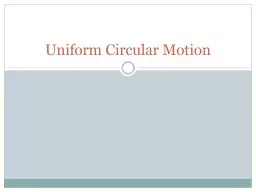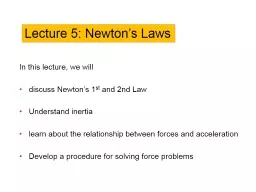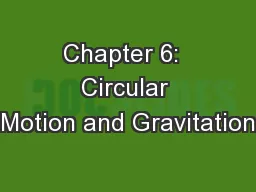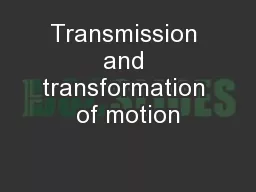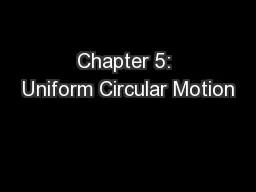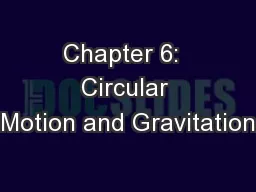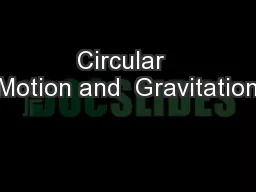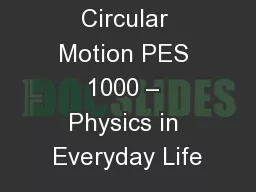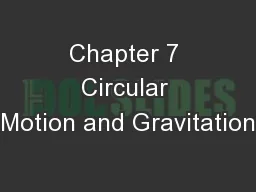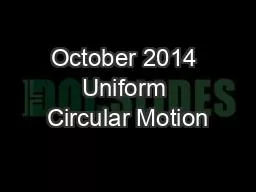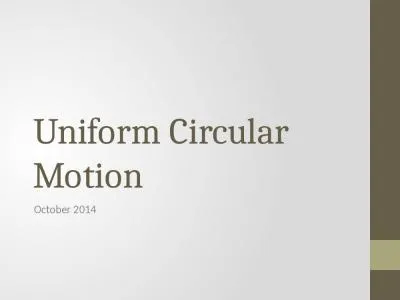PDF-Chapter 5 -Uniform Circular Motion
Author : alexa-scheidler | Published Date : 2016-05-19
Download the PowerPoint presentation from the Chapter 5 -Uniform Circular Motion
Presentation Embed Code
Download Presentation
Download Presentation The PPT/PDF document "Chapter 5 -Uniform Circular Motion" is the property of its rightful owner. Permission is granted to download and print the materials on this website for personal, non-commercial use only, and to display it on your personal computer provided you do not modify the materials and that you retain all copyright notices contained in the materials. By downloading content from our website, you accept the terms of this agreement.
Chapter 5 -Uniform Circular Motion: Transcript
. Chapter 5. Learning Objectives- . Circular motion and rotation . Uniform circular motion. Students should understand the uniform circular motion of a particle, so they can:. Relate the radius of the circle and the speed or rate of revolution of the particle to the magnitude of the centripetal acceleration.. A bunch of stuff you’ll see on the midterm exam. Question 1. Give the formula for speed in a circle of radius r. Give the formula for centripetal acceleration. Give the formula for centripetal force. 5.1 . Uniform Circular Motion. DEFINITION OF UNIFORM CIRCULAR MOTION. Uniform circular motion is the motion of an object . traveling at a constant speed on a circular path.. 5.1 . Uniform Circular Motion. Circular Motion Lab Results. Part 1: Radius’ effect on velocity. Mass, centripetal force kept constant. Part 2: Mass’ effect on velocity. Radius, centripetal force kept constant. Part 3: Force’s effect on velocity. Centripetal acceleration. Problem solving with . Newton’s 2nd Law . for . circular motion. Lecture 8: Circular motion. Effect of force components . Components of force parallel and perpendicular to velocity have different effects.. © 2016 Pearson Education, Inc.. Goals for Chapter 6. To understand the dynamics of circular motion.. To study the unique application of circular motion as it applies to Newton. '. s law of gravitation.. Carry the motion over a distance. And. Change the type of motion. Transmission of motion. A group of simple machines can work together to make a . system. .. A system can transmit or carry the motion from one object to another.. 5-1 Uniform Circular Motion. Uniform Circular Motion. : The motion of an object traveling at a constant (uniform) speed on a circular path. 5-1 Uniform Circular Motion. Since we are dealing with object moving in a circle, it is convenient to talk about the . © 2016 Pearson Education, Inc.. Goals for Chapter 6. To understand the dynamics of circular motion.. To study the unique application of circular motion as it applies to Newton. '. s law of gravitation.. Can you change your velocity while not changing your speed?. v. F. Consider the above situation.. According to Newton . S. econd law, what must the object be doing?. It is accelerating so the velocity must be changing.. Uniform Circular motion. For an object moving on a circle at constant speed. The . speed is constant. , but the . direction is not. Acceleration is a change in velocity, but speed is constant. The change in velocity is only in its direction. Circular Motion. Objectives:. 1. Solve problems involving centripetal acceleration.. 2. Solve problems involving centripetal force.. 3. Explain how the apparent existence of an outward force in circular motion can be explained as inertia resisting the centripetal force.. Uniform circular motion. What does the word “. uniform. ” mean here?. . constant radius. and . constant speed. . Velocity vector is tangent to the path at each instant, so direction of velocity vector changes all the time as the object moves in circle. . Circular . Motion. A. is towards the center.. V . is tangential to the motion. Speed is constant, . V. changes. A force directed towards the. center is what causes the. . acceleration (e.g. gravity, .
Download Document
Here is the link to download the presentation.
"Chapter 5 -Uniform Circular Motion"The content belongs to its owner. You may download and print it for personal use, without modification, and keep all copyright notices. By downloading, you agree to these terms.
Related Documents

